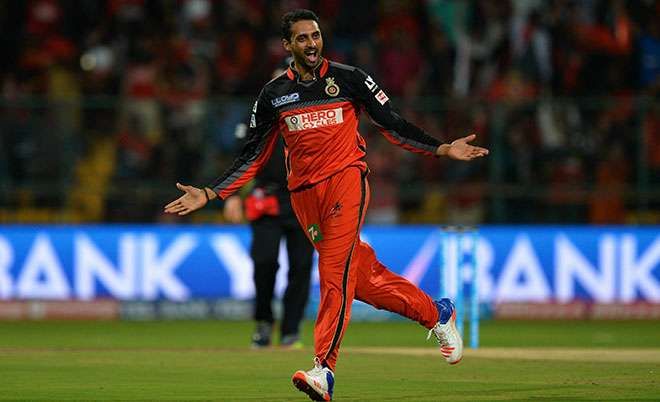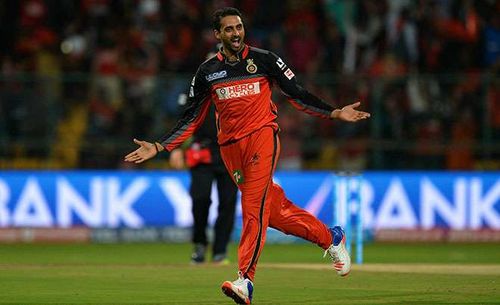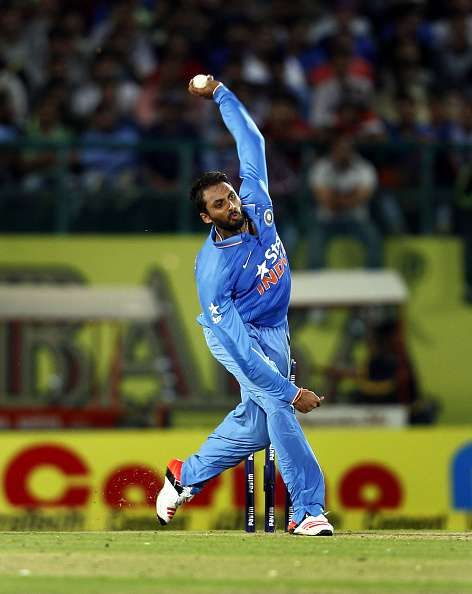
Bruised but not broken: An interview with Sreenath Aravind, RCB's unsung hero
Royal Challengers Bangalore’s cinematic rise, and the unfortunate anti-climax made for a captivating story in the IPL this season. As the world went gaga over Virat Kohli’s superhuman abilities, the one-man show overshadowed the other notable contributions by the rest of the members.
Sreenath Aravind was one such component of a resurgent RCB team that almost attained the improbable. After missing out on a couple of games in the initial phase of the season, Sreenath re-entered the starting XI with the bowling attack gasping for respite from repeated thrashings. Aravind’s fluidic bowling brought a much-needed calm in all the frenzy, and gave the attack a shape.
With his left arm seam, Aravind snapped a wicket in each of his first overs in four out of the next five matches, and RCB, mouldering at the sixth spot in the table, suddenly breathed fire and reached the finals.
Kohli’s mindset rubbed on everyone else in the dressing room, and players were assigned specific targets to adhere to. “We were told that we have to win one match at a time and keep it simple. I was thinking about just my bowling. My aim was to get one wicket every over, and force the batsman to play to my line”.
With Kohli in the form of his life, RCB made giant strides to reach the playoffs. It seemed as if the captain was hitting centuries at will, and the team was by his side during the spectacular run.
“We were very excited. He is a true gentleman, and we used to respect him. He said it is for the team. It turned it into a good vibe, and goaded us to play for the team. He is a gem of a person”.
Facing such a run-machine in the nets would be a monumental task in itself. Aravind still managed to get his way through Kohli’s defences. He got him caught behind, even bowled. Calls for a little momentary celebration, doesn’t it? “We would just quietly turn back after dismissing him. He would applaud us after a good effort, and we would do the same.”
In a team that comprised of the likes of Kohli and AB de Villiers, fielding can’t be a neglected aspect. The RCB coaching unit made sure that even practice sessions replicated match situations.
“After the nets, we used to have practise sessions, and we used to consider it like a match, with all catches being important. We used to take it as a challenge, and not be loose, even for a second. If we fumbled or dropped a catch, we would consider it to be a bad day for us.
“We always had to be on our toes. This made us believe we were the best fielding side. Kohli and ABD (De Villiers) are the best in RCB. I used to bowl to them, and they used to hit even the good balls. I used to ask them about their mindset against the bowlers.”
While others like Kohli swear by a strict diet, Aravind prefers to stay close to his roots and gorges on simple food. “I personally have just normal food: Rice, sambhar and curd. Other take protein like chicken and mutton. It is not about diet, but skill is where you can improve on the cricketing field.”
There is one aspect about Aravind that few people are aware of. His ability to bowl off-spin. He switches to spin sometimes midway during matches, based on the situation and conditions.
“While bowling in the nets, I used to be very tired after an hour and a half. There were no spinners, so I switched to bowling spin. The confidence slowly built in me, and I started trying it in the Ranji nets’.
There is a minor blip in his IPL success chart. During a match between RCB and Rajasthan Royals in 2012, Ajinkya Rahane carved Aravind for fours of all six balls of his over. “At that time had a niggle in the knee, it was not in proper position and it was moving all along.
Also Read: 5 unsung heroes from IPL 2016
“I played without a PCL and ACL for five years. Off days will be there for everyone. I take a positive note of where I can improve. I remind myself that it is not my last game, and there is a lot more to come”.
Those who have followed the Bangalore-based franchise’s exploits over the last few seasons must have observed Aravind’s prowess as a wicket-taker, a vital piece that fits into any puzzle with ease.
However, the road has not been one filled with roses, but a treacherous path with injuries giving both physical and mental trauma. Although injuries do crop up in a bowler’s career, an unfortunate accident on the cricket field, that nearly brought an end to his career, required proper rehabilitation and loads of guts to make a comeback from.
While fielding during a Buchi Babu match in 2008, Aravind, going for a skier, collided with wicketkeeper KB Pawan, and damaged both the ACL and PCL (Anterior and Posterior cruciate ligaments) of his knee. He was told that he won’t be able to play cricket again.
“It was very difficult. Injuries are bound to happen in sport, but in my case, it was an accident.” It was then that Muthu Kumar, his team physio, became the guiding light and showed him the path to recovery.
“He suggested me to meet Dr. David Rajan in Coimbatore. Rajan sir said that even footballers manage to play without PCL and ACL, cricket is less of a physical and more of a game of ability. That thought struck my mind”.
He was advised surgery which was expected to extend his career for just two more years. But Aravind was willing to take the risk, and under the guidance of Mr. Muthu, ready to go through the rigours of a painstaking rehabilitation.
“It took me six months to about a year to regain my lost strength. Willingness is the key”
From there, the curve went only upward. Domestic to KPL to the IPL, and finally the Indian jersey, life came full circle for Aravind 2.0
His first taste of international cricket was when he was called up during India’s tour to England in 2011. Being the highest wicket taker for the RCB that year, he was included as a replacement for the injured Zaheer Khan. Yet, he could not break into the playing XI.
“I was very happy after the call-up. But, the team balance is such that everyone can’t fit in. It has been a bit in and out, and there has been some sadness, but it is a matter of time.”
An Indian call-up looked inevitable at times, with Zaheer Khan’s dwindling form and his regular run-ins with injuries. Although Aravind finally made the cut against South Africa in a T20 in October last year, the role given to him as a debutant was as challenging as it could get.
Bowling the final over, he was asked to defend 10 runs off six balls, not a tall task for batsmen to get in this T20 era. “Dhoni asked what my best was. I said yorkers. He was very clear and I was very clear.”
The experienced Duminy got the runs off the first four balls, and a distraught Aravind trudged back to the pavilion. “Nobody can say there is no pressure on the bowler or a batsman, in a ‘competitive way. I was 100 % sure of the yorkers, where I had developed myself in the right line.
“I was bowling in the nets, and they were happy with it. Dhoni trusted me. It was a great opportunity. But unfortunately, it went for a six. It happens. “
After the match, a calm Dhoni approached the debutant and gave him sane words of advice.
“MS Dhoni said, ‘well bowled, but you could have bowled better. Keep working hard and you can do better next time’. He is a senior player and knows the game from behind the wicket.”
Things are not always pre-devised, and the bowler needs to constantly improvise to outwit the batsman. “There is a plan A and plan B. We can’t keep one plan and bowl. A batsman can convert a yorker into a full toss, so I might resort to a slower ball or a bouncer. You have to keep plans to overcome the batsman. My strength is bowling off-cutters and slower ones”.
The mastery over such a wide array of deliveries took time, and much like any other kid, cricket started with the ubiquitous tennis ball. “I played my junior cricket tennis ball. Later, I started to play for Jai Karnataka. From there, I joined Santosh Menon’s club. My uncle used to take me there, and I used to bowl with the hard ball, interested in this kind of stuff. My passion developed there.”
The jump from club to domestic cricket must is massive for a youngster, and it required an understanding of the grip and shine of the ball to go on to the next level. Serious cricket beckoned.
“Nobody taught me the grip. I used to follow my uncle, but he was a right-hander. Later, I came to the KSCA academy, where I was coached by Sanath Kumar and Alex Sir. They provided me some tips on the grip and swing and release of the ball.”
As he got into the Karnataka side, he understood that his game needed a push, and it required skills that differentiate him from the others. As a youngster, Aravind used to follow Wasim Akram. Not surprising, as Akram was an idol for a number of young pacers. Aravind learned the nuances of swing and seam bowling from the Pakistani legend.
“He used to be my role model, and is still now. I used to see his videos. I rely on swing, and the shine and seam position. On the perfect side, you’ll get the swing. My thing is very limited, I don’t have anything extraordinary, but I can bowl perfect balls with the seam, and I aim to master that.”
Getting the Indian cap was one of the biggest highlights of Aravind’s career, but It wasn’t always hard work in the dressing room, and the senior players made it a point to make the newcomers comfortable. Aravind recalls one such instance :
“Once, we decided that we would have a group of notes where we had to give certain points to batsmen and bowlers. I was representing the bowlers, and Stuart (Binny) was representing the batsmen. When Raina’s chance came, he turned to me and said ‘You are the boss of the team’. That was a good moment, and it made me realise that they also considered me to be a family member”.
Captain Cool did his part to ensure that the youngster’s stay in the dressing room proved to be a learning curve, and that he constantly improved himself to get better and better.
“On a very good note, Dhoni used to tell us to work hard. He is very cool and taught us many things, like being positive both on and off the field. There are no negative things that are coming out. It was like a family. There are no hot-headed guys in the dressing room. There were all fun-loving guys.”
The disappointment of realising that he is 32, and an Indian recall is becoming tougher every day, does bother him a bit, but he is willing to put in the hard yards and continue. “I never depend on my age, it is all on the present day. I am happy. I may or may not (make it to the national team), but I am happy in the present.”

